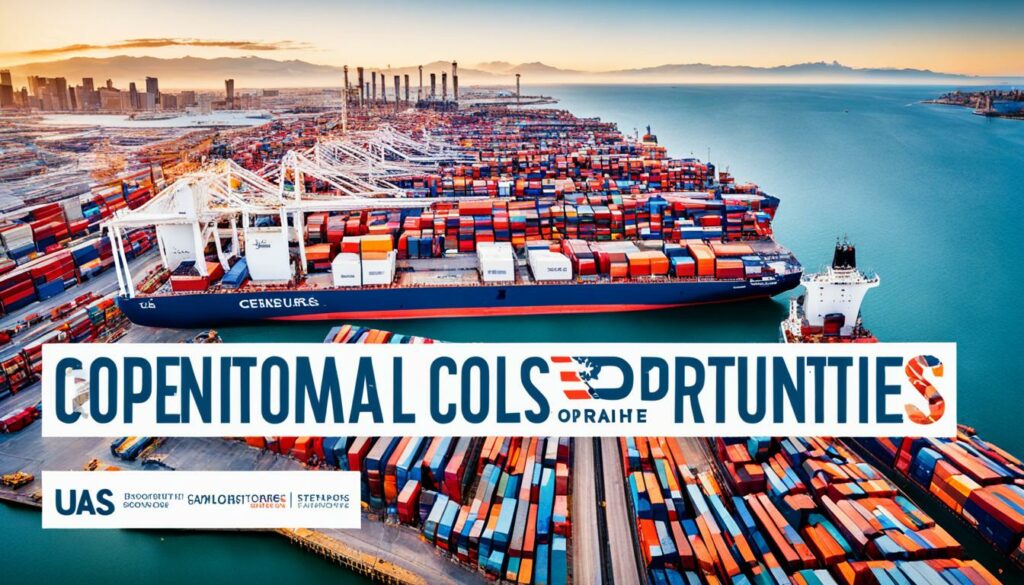Menu

Do you know the U.S. Trade and Development Agency (USTDA) brings in $231 in exports for every dollar spent? This shows big chances for export partnerships in the US. Exploring global market alliances can find great networking chances that lead to good joint ventures.
I am keen on exploring export opportunities in the US. Thanks to the USTDA, over $119 billion in U.S. exports has gone to infrastructure projects in emerging countries. For example, a deal with Indonesia’s Nusantara Capital Authority has boosted smart city projects.
Focusing on networking efforts can enhance cross border ventures. Also, the US Department of Commerce is making important deals, like with Kenya. These partnerships aim to increase digital skills and grow economies sustainably.
Today, knowing about import-export partnerships is key for business success. These partnerships help companies enter new markets worldwide. Using local support is crucial. Research shows 87% of winners get help from locals.
Trade Commissioner Service (TCS) boosts sales for companies, operating in 160+ cities. Companies using TCS export 20.5% more and reach 20.9% new markets. TCS plays a huge role in making international business ventures easier. This shows how vital export partnerships are for global growth.
Creating an export plan is vital for success. A plan boosts export growth for 92% of companies. To succeed, it’s important to follow product and packaging rules. 80% stick to foreign standards. And 70% following U.S. rules find exporting easier.
| Key Factor | Percentage Success |
|---|---|
| Utilisation of Local Resources and Assistance | 78% |
| Effective Negotiation of Sales Contracts | 65% |
| Management of Payment Risks | 75% |
| Accurate Compliance with Foreign Import Regulations | 88% |
| Completion of Shipping Documents on Time | 82% |
Getting involved in international business ventures and building strong import-export networks opens up new opportunities. U.S. small and medium companies gain the most from international trade. Nearly all the 280,000 U.S. exporters are small to medium. They do better by trading internationally. Planning and working well with others are key to business growth.
Export partnerships are full of benefits. They are ideal for businesses looking to expand globally. By joining hands with others in overseas trade, companies strengthen their presence in the market.
They also become more resilient. This helps them weather the ups and downs that come in business.
Export partnerships open up big markets for businesses. More than 95 percent of the world’s consumers are outside the United States. The demand for various products is also growing globally.
In 2022, the world traded goods and services worth nearly $31.34 trillion. This shows the huge market waiting to be touched. For instance, BMW’s plant in South Carolina exported over 227,000 cars to 120 countries last year. They made nearly $9.6 billion from this. Such a broad reach highlights the benefits of joining export partnerships to find new customers.

Export partnerships help businesses deal with risks. By spreading out into different markets, they aren’t as affected by problems in one place. This cushions them from local economic shocks.
Businesses that deal globally manage economic ups and downs better. The support from the U.S. Department of Commerce’s worldwide Commercial Service network is also crucial. They provide special export support. This support makes it easier for companies to handle risks well.
Export partnerships can also save money. Companies can make their supply chains more efficient through these collaborations. This leads to saving costs and enjoying benefits from working at a larger scale.
Selling overseas helps businesses grow faster. It creates more jobs and increases what employees earn. Thanks to eCommerce and improved shipping, costs are kept low. Also, free trade agreements make this strategy more attractive for businesses of any size.
| Statistic | Details |
|---|---|
| Annual U.S. Exports | Over $3 trillion in goods and services |
| Exporting Firms | Over 286,000 US businesses |
| Top Export Markets | Germany, Japan, Canada |
Looking into the US market dynamics opens doors for global businesses. They want to work closely with American partners. This means understanding how the economy works and what Americans buy. It’s also key to know the rules that businesses need to follow. This way, they can meet local needs and do things the right way.
The success of global businesses is tied to the economy. The U.S. Trade and Development Agency (USTDA) shows this well. For each dollar they use, $231 in U.S. exports happen. This support also helps the U.S. export over $119 billion to growing countries for projects. This shows a strong system for exports.
Knowing how Americans shop is critical. It helps businesses tailor their offerings to the US, bringing them success. For instance, the U.S. and Mexico traded $779.3 billion worth of goods in 2022. This big trade includes items like cars, technology, and health gear.
Dealing with rules in the US is key for global success. Projects like those given by the USTDA to help Indonesia’s smart cities and improve internet in Africa highlight this. Businesses need to follow the laws to build strong trade partnerships. This is essential for both American and global progress.
Seeing potential partners is vital for international business teamwork to begin. By using business contacts, joining trade groups, and doing thorough research, you up your chances hugely. These steps help a lot in making better business links.
Using friends and meeting new partners helps find trusted distribution pals. Networking events let companies with similar goods connect you to the right people. This way, you build a solid group that can make your search for partners easier.
Working with trade groups is another good move. Going to trade shows, especially if there’s a SWISS Pavilion, can get you in front of others. They help you meet partners in a structured way, boosting your chances of finding the right match for your business.

Take time to look deeper into markets to find the right fit. Research online, attend shows, and look at trade numbers. Using the help of Switzerland Global Enterprise could point you in the best direction. This ensures you make smart choices when picking partners for your global moves.
Evaluating and researching well are key in finding trustworthy business allies, making sure they are committed and reliable.
In the end, finding the right partners for international projects is all about wise networking, trade group’s help, and solid research. These moves build a strong base for your worldwide business alliances.
Building trust with US business partners is key to success in global market alliances. This matters a lot in all parts of working together. It affects how well and quickly things get done.
Good communication is crucial for trust. Being clear and regular in what we say helps keep global market alliances strong. North America’s trust, says Harvard Business Review, relies on how open and consistent we are. Businesses must act first to clarify things and make their partners feel secure.
Understanding cultures is vital for international business ventures. Knowing what’s expected helps us connect better with others. Matching our actions to local ways builds a better situation for working together and achieving common goals.
Talking often and keeping people up-to-date helps keep trust. Regular updates and getting feedback show we’re serious and dependable. This builds trust back and opens new chances for strong global market alliances. We should share trust with care yet boldly, which boosts our success.
In wrapping up, trust with US business partners is key. We need clear talk, awareness of cultures, and staying in touch. This is crucial for success in international business ventures and making global market alliances solid.
For those in international business, knowing the legal rules is crucial. This helps keep trade collaborations honest and within the law.

Rules on compliance differ greatly worldwide. Knowing local laws and global standards is key. This involves following local trade rules, taxes, and environment laws. Keeping up with any changes is vital for staying compliant during business abroad.
IP protection is very important in global trade. Getting patents, trademarks, and copyrights helps protect products and ideas. International IP laws are complex and need expert advice. Research from MDPI shows protecting IP improves a business’s chances.
Good, clear contracts are vital for international success. They should clearly state what each party must do. It’s important to include payment, delivery, and how to solve disagreements. Strong contracts help lower risks and build trust.
Understanding laws and rules is vital for thriving in global business. By following regulations, protecting IP, and having good contracts, companies can make their ventures successful and safe.
Starting export partnerships mean knowing finances well. You must look at lots of ways to get money. Also, make sure you pay attention to spending and reducing the risks involved in money matters.
Getting the right money is key for going global. You should think about all possible ways to finance your business. This includes grants, investors, and help for exports. If you make a plan first, you might get your loan faster. And right now, there’s a program offering up to $300,000 for export projects.
Managing costs well is crucial for export partnerships. Companies spend about 20% of their budget on marketing. They use a lot of digital tools for this. Plus, 30% add the cost of taxes and shipping to their prices. This helps them be smart with their money.
Knowing and dealing with financial risks is a must. About 60% of firms check their money risks when they go global. Looking at how the economy or politics might change is important. This helps businesses deal with money troubles and keep their partnerships strong.
Understanding these financial aspects really helps businesses. It lets them take on export partners wisely. Being well-prepared financially is key to success in the growing global market.
Good use of government resources greatly helps businesses go global. We will explore how to use resources like those from the U.S. Trade and Development Agency, the Global Diversity Export Initiative, and help from Switzerland Global Enterprise. These groups give important support to companies going global.

The U.S. Trade and Development Agency helps connect U.S. businesses to new markets. It has hosted many webinars over the past 18 months. These share deep knowledge about using these government resources. The U.S. Commercial Service also works closely with the Export-Import Bank of the United States (EXIM) to assist in matchmaking and events like “Discover Global Markets”.
The Global Diversity Export Initiative encourages global teamwork and inclusivity. It’s designed to help companies build new trading partnerships. The U.S. Export Assistance Centers (USEACs) and District Export Councils (DECs) offer valuable help, making it simpler to navigate world markets.
Switzerland Global Enterprise offers key help in making export partnerships work. They give tailored help and important advice. This makes it easier for companies to understand what they need to start exporting. They are especially helpful for businesses in the upper Midwest aiming to grow their exports.
| Government Resource | Key Services |
|---|---|
| U.S. Trade and Development Agency | Connecting U.S. businesses to opportunities in emerging markets. |
| Global Diversity Export Initiative | Promoting inclusivity in international trade collaborations. |
| Switzerland Global Enterprise | Providing strategic assistance and enhancing export readiness. |
| U.S. Commercial Service | Offering matchmaking appointments and organising significant events. |
| EXIM Short-Term Export Credit Insurance | Benefits include increased competitiveness, protection against nonpayment, and better access to working capital. |
It’s key for businesses to explore industry-specific opportunities. This is crucial for making the most of *export partnership opportunities*. By looking into the unique needs and insights of different sectors, companies can set up trade deals that boost innovation and growth.
For tech businesses, using data from the U.S. Census Bureau and the Bureau of Economic Analysis is key. This info shows what the U.S. needs and what could be exported. The Canadian Trade Commissioner Service’s studies are also very helpful for in-depth research.
Getting involved in new tech markets can meet future demands and push tech forward.
Manufacturing is ripe with *export partnership opportunities*. Places like the U.S. Center for Advanced Manufacturing and the AMT can give vital support. They share information and help with trade.
Organisations such as the National Custom Brokers & Forwarders Association of America can help too. They can assist businesses in getting their products out globally. This makes manufacturing and trading on a global scale easier.
In healthcare and pharma, linking up with AdvaMed can be a game-changer. They have over 400 members across the globe. AdvaMed works to better medical technology and health.
Detailed data from the U.S. Census Bureau can help find exact healthcare needs. This means companies can create tailored export opportunities. Export Development Canada also offers tools to guide businesses through this sector. This support makes it easier to build strong export partnerships.
Focusing on *export partnership opportunities* in your specific industry can open many doors. It allows businesses to grow and innovate within their sectors.
Keeping import-export partnerships and international business ventures strong over time is crucial. By sticking to important best practices, we can keep partnerships healthy. This helps in growing together and achieving success for both sides in the long run.
It’s key to talk often and openly for a partnership to work well. Sharing updates, talking about challenges, and celebrating wins together builds a strong bond. It also helps in working towards shared goals. Using modern platforms and setting regular meetings can make communication smoother.
At the beginning, partners must set clear goals. This ensures that everyone knows what they’re working towards. Regularly checking these goals helps in staying focused. And if the market changes, partners can adjust their strategies together.

Evaluating how well a partnership is doing from time to time is crucial. Partners should have clear measurements for success. This lets them see where they’re doing well and where they need to improve. And it allows them to adjust strategies as necessary to keep up with changes in the market.
In international business, a clear plan and continuous reviews are vital for success. By talking regularly, setting clear goals, and checking how we’re doing, we can make our partnerships stronger and more successful.
Successful export partnerships show the power of working together globally. They highlight the importance of making important connections in the business world. Looking at these real success stories teaches us how to grow internationally.
The American Indian Alaska Native Tourism Association (AIANTA) used smart partnerships to boost their local economies. They saw a US$500 million increase in global sales by focusing on cultural and eco-friendly tourism. By making these types of trips more popular, they were able to compete with big names in the travel industry yet remain affordable.
The NGLCC shows how meeting the right people can lead to big business success around the world. They connect with big companies and governments to help smaller businesses grow. This approach not only breaks down business barriers but also encourages everyone to trade together in a fair and supportive way.
The National Business League proves that local support is key to long-term business success. It helps companies get certifications that make customers trust them more. This trust helps small businesses do well. The League shows how good policies can help or hurt a company’s chance to sell abroad fairly. They work with developing nations to open up new fair trade chances that also help communities grow.
Starting export partnerships faces several hurdles. These include understanding cultural differences, solving logistical issues, and managing financial problems. Strategies like forming cross-border joint ventures and import-export partnerships help overcome these obstacles.
Cultural gaps are a big issue in export partnerships. They can slow down progress by creating misunderstandings. Thomasnet.com sees about 20% of its visitors globally, showing diverse backgrounds. Companies should train their staff in cultural sensitivity and welcome their international partners warmly. This step boosts mutual respect and paves the way for successful partnerships.

Problems with logistics can disrupt cross-border ventures and add to costs. Supply chain failures and a tough market are common challenges. It’s vital to do in-depth market research and establish strong supply chain management. Looking for niche markets, like exporting fragrant rice to Niger, can offer chances to avoid market saturation.
Dealing with money issues is key in export partnerships. Problems include finding funds, managing costs, and evaluating financial risks. Experts advise reducing risks early to handle these financial challenges. Taking a careful approach to finance is essential. Nearly half of the new work found on Thomasnet.com comes from leads there, underlining its financial benefits. Plus, knowing key regulations like the U.S. Foreign Corrupt Practices Act and joining Global Diversity Export Initiatives in May can strengthen financial health.
Overcoming these difficulties with focused solutions is crucial for successful ventures and partnerships. With most global customers residing outside the U.S., the opportunity for American goods and services is vast. Thorough preparation and smart planning can help clear these hurdles and ensure worldwide success.
Technology is changing how companies work with others worldwide. This shift is making it easier to find business networking opportunities. Many U.S. small businesses are using tech tools to improve their export partnerships.
Data analytics helps companies to make better decisions and find new chances for growth. Because of this, small businesses saw a 20% increase in export earnings since 2016.
Good communication is key to strong global market alliances. Today’s communication tools make it easy to connect and work together across the world. Platforms like Zoom and Microsoft Teams make it simple to talk with partners far away.
Managing export projects can be complex. Project management tools make it easier to plan, do, and check on projects. They help businesses stay on track and reach their targets. Plus, online platforms and third-party logistics can simplify shipping, making international trade smoother.
Currently, only 9% of U.S. small businesses export their products. By using these tech tools, companies can have more success in foreign markets. This approach opens up more chances to work with other businesses globally.
| Technological Tool | Function | Example |
|---|---|---|
| Data Analytics | Analysing market trends and customer preferences | Google Analytics |
| Communication Platforms | Facilitating seamless interaction | Zoom, Microsoft Teams |
| Project Management Tools | Managing and monitoring projects | Trello, Asana |
In wrapping up, exploring export partnerships in the U.S. has shown great potential for business growth. The U.S. Department of Commerce’s International Trade Administration highlights the power of exporting to create jobs. For every three manufacturing workers, exports can add a million new jobs.
Yet, some research points to a more complicated link between export growth and jobs, with some showing negative connections. Take Indiana as an example, where exports grew threefold from 1998 to 2013. While some industries like food made more jobs with more exports, many saw jobs drop.
The success in these partnerships can be boosted by modern tech tools. Things like AI risk tools, blockchain, and specific industry solutions make exports easier and safer. Platforms like Tradologie show how digital innovation can change traditional trading for the better.
The journey into export partnerships isn’t easy but offers big rewards. It’s all about understanding markets well, using government help, and embracing new technologies. This not only helps the economy but also creates ethical and lasting supply chains, giving businesses a strong global position.
Export partnerships bring market expansion, risk sharing, and cost efficiencies. They help companies enter new markets. They also cut financial risks and save money through bulk buying.
Knowing the US market’s economy and consumer needs is key. It allows businesses to shape their plans to fit local expectations and laws. This leads to better trading and stronger business abroad.
Great tactics are using business connections, working with trade groups, and deep research. These help find reliable and effective partners. They also open up opportunities for working together across borders.
Trust is vital for export deals. Good communication, understanding each other’s culture, and staying involved are key. This helps in making lasting partnerships.
Following laws, protecting your ideas, and sticking to agreements are crucial. Mastery of these areas keeps your global business deals safe and sound. It also supports success in trading together.
Looking at how to finance your export plans, managing costs well, and checking financial risks are all very important. These steps make sure businesses are ready, financially, for global ventures.
Agencies like the U.S. Trade and Development Agency (USTDA) and others offer big help. They provide support, links, and sometimes funding. This support is valuable for starting export deals.
The tech, manufacturing, and health sectors have special opportunities for export work. They allow companies to focus on unique needs and growth. This leads to strong, innovative partnerships.
Staying in touch, having clear goals, and regularly checking your progress are vital. These steps keep your partnerships strong. They also help you do well in business abroad.
Good examples are AIANTA and Native Tourism, which boosted tourism’s economic effects. Also, the partnerships supported by NGLCC and The National Business League. These show how key networking is for business success.
Language differences, problems with moving goods around, and financial issues can be tough. But by creating smart, joint solutions, partners can avoid these and grow. This strategy is key to overcoming export dealing challenges.
Tools like data analysis and efficient communication make partnerships stronger. They support better connections and business networking in the global market. This is important for doing well in the export market.